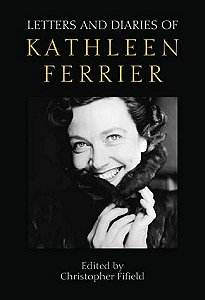The close of 1953 witnessed the tragic deaths,
in sad succession, of three young performing artists of rising
international stature. Two of these, the pianists William Kapell
and Noel Mewton-Wood, were each only thirty-one years old, barely
begun on the road to fame and greatness; the third, the incomparable
contralto Kathleen Ferrier, while ten years older, enjoyed a professional
career of only similar length: a mere decade or so.
The fiftieth anniversary of Ferrier's death from
cancer is being commemorated in this country by, among other events,
both the recent first release of an off-air performance of Mahler's
Das Lied von der Erde given with Barbirolli and the tenor
Richard Lewis in 1952 (APR5579) review,
and the first publication, in the volume under review, of her
letters and diaries covering the years from 1940 until her death.
There are just over 300 letters, many hitherto
unpublished and deriving from a cache of correspondence discovered
by editor Christopher Fifield in the offices of music agents Ibbs
and Tillett, for whom Ferrier was one of their sole artists. They
are divided into eight chapters, the first given over to the years
1940-47, the others having each a year to itself until 1953. Each
chapter is headed by a vital and informative biographical introduction
provided by the editor. As well as the letters to Ibbs and Tillett,
those most prominent here are to Ferrier's sister Winifred, her
favoured Canadian accompanist John Newmark, her American friends
Benita and Bill Cress, Benjamin Britten and Peter Pears (whose
creativity joined hands with hers in a number of collaborative
artistic endeavours, notably The Rape of Lucretia, the
Spring Symphony and the canticle Abraham and Isaac),
and her beloved conductors John Barbirolli and Bruno Walter.
In all, this correspondence delivers on reading,
in its present format an impact far exceeding the often mundane
nature of its content, which on thr surface is largely concerned
with the daily minutiae oif a touring artist's life. What emerges
is a vivid self-portrait of a brave, secure woman in love with
life and music, whose joie de vivre was palpable and supported
both by a notable lack of inflated egoism and a singular sense
of humour which rarely faltered, even towards the end.
Here is a short example, taken from a letter
to Winifred written from New York during her second trip to America
in 1949, shortly after confronting her agent there and successfully
negotiating a rise in fee for the following year:
To give me courage I bought a new hat, bag,
shoes, stockings and summer nylon pantie girdle, and could
have coped with a whole blinking board of directors. I have
only sagged a little now, having discovered that the tab on
my dress had been sticking out at the back of my neck all
the time. I thought people were looking at me, but I thought
it was admiration!! That'll larn me! (Letter No.112)
I was personally pleased to discover in these
pages, for the first time anywhere, some indication of Ferrier's
involvement with E.J.Moeran's last solo song Rahoon, a
bleak masterpiece which he wrote for her in 1947. Although I had
hitherto assumed, having found no reference at all to the matter
elsewhere, that Ferrier may not actually have performed the song,
it is now clear that she sang it regularly during the years 1948-50,
in tandem with another, very different Joyce setting, The Merry
Green Wood. She even writes out the poem in Letter No.84, though
without prior knowledge one would not know she was referring to
a song by Moeran. This is one instance among others where I felt
the need for an in-text editorial annotation, of which there are
none in the volume. Moeran's name is in fact only included in
the Index of Works: it appears in neither the Personalia nor General
Index.) If only Ferrier had recorded Rahoon!
The Diary section is perhaps of rather less immediate
interest, being simply a daily listing of social appointments,
meetings and concert dates, with occasional personal comments
attached, but never a whisper of self exploration.
It is perhaps best read as an amplification of
the context in which the letters were written, and reveals Ferrier
as far more extravert a person than her recordings lead one to
imagine. As such it helps act as a welcome antidote to the death-surrounded
image so often attached to this artist because of what she sang
(Kindertotenlieder, Das Lied von der Erde, The
Dream of Gerontius for instance) and the way she died.
Anyone interested in Kathleen Ferrier's life
and art and the milieu of the Second World War years and their
aftermath by which they were embraced, will find this welcome
book required reading. It is above all, and despite the final
descent, a celebration of living.
© John Talbot
